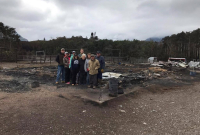Support strong Canadian climate journalism for 2025
Lockey Craig figures he'll be long gone by the time Waterton Lakes National Park returns to its former beauty.
"I'm 56 so I'm thinking before I die, it won't look good," says the president of Waymarker Hospitality, which runs several hotels and restaurants in the southwestern Alberta park.
A powerful wildfire tore through Waterton about two weeks ago. Fire crews managed to save the townsite, but many other parts of the mountainous park were torched, including popular hiking and boating spots.
"It will be decades before the forest looks like it used to, no question about that," Craig says.
"The long-term impacts on the guest experience and visitation in Waterton are going to be horrific, no question about it. The backcountry is burned to a crisp."
Craig expects a lot of people will stop by the park next summer out of curiosity and that the biggest dip in tourism will come in subsequent years.
Waterton was hosting record numbers this year — thanks mainly to free national park admission to mark the 150th anniversary of Confederation — until the fire forced everyone out in early September.
Ordinarily, more than half a million visitors visit the park each year. Most trips there take place over the summer and most businesses are closed in the winter.
Nikolaus Wyslouzil, executive director of the Chinook County Tourist Association, says it's too soon to tell how long it will take for the park to bounce back.
"Certainly the scenery will be different. If you're taking the boat down the lake or you're in one of the areas where you have a good view, that's going to be totally different from what it was and it will take a number of years to regrow," he says.
"We don't know what Parks (Canada) might be planning. Will they be doing some reforestation? Will they engage in sort of massive cleanup?"
Some have a more positive view on Waterton's future.
University of Calgary professor Edward Johnson, who studies the connection between geoscience and ecology, says periodic wildfires are part of the natural life cycle of a forest.
The heat from the fire will cause some pine cones to open and release their seeds. New trees and plants will have the opportunity to regenerate in mineral-rich soil.
"In some ways, the fire in Waterton was not a disaster in that ecological sense, but in fact a kind of rare opportunity for us to see this dynamic process in action in the next 10 or 20 years," he says.
Parks Canada has confirmed some animals died in the fire, but says there is still life in Waterton.
Populations of mice tend to flourish after a fire, drawn by herbaceous plants that sprout up afterward, says Johnson.
It will be about two decades before the trees in Waterton are taller than people walking through the forest, he adds.
Mike Flannigan, who directs the Western Partnership for Wildland Fire Science at the University of Alberta, says fires help maintain biodiversity and kill off diseases.
"It resets the clock. It's just the cycle of life," he says.
It could take a century for trees to be full-size again.
"But you'll see Mother Nature at work. You'll see seedlings and then saplings and you'll see new types of flowers, fireweed," he says.
Flannigan says there are some lessons to draw from a rash of wildfires in Yellowstone National Park almost three decades ago. About 36 per cent of the park straddling Wyoming, Montana and Idaho was affected, U.S. National Park Service figures show.
"The park actually took advantage of this and said 'let's educate people that fire's a natural process and see all the changes that take place over the years,'" says Flannigan.
"Hopefully Waterton will take a similar approach."





Comments